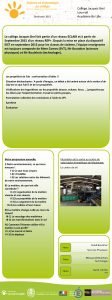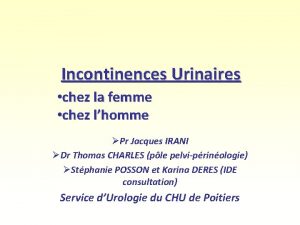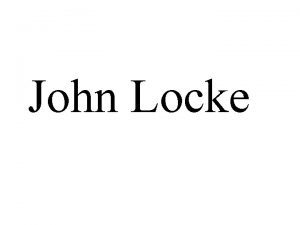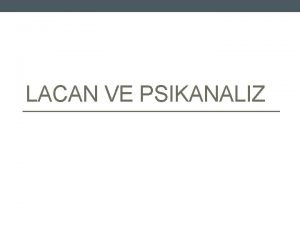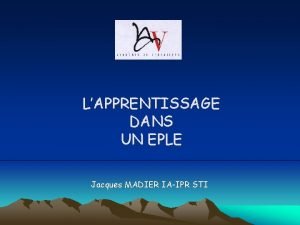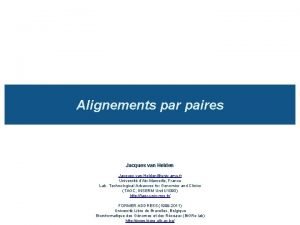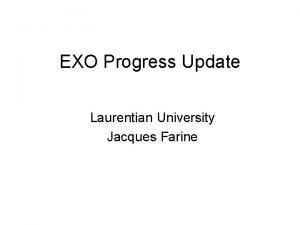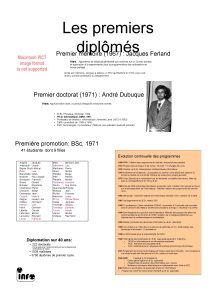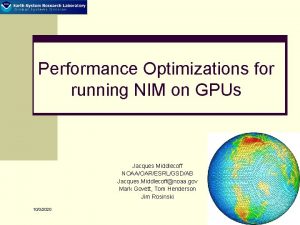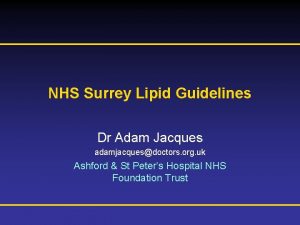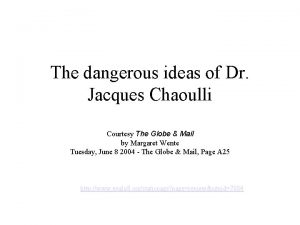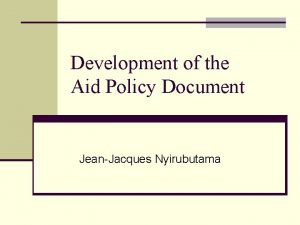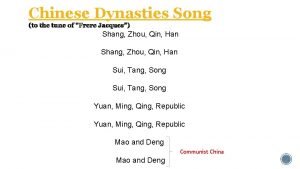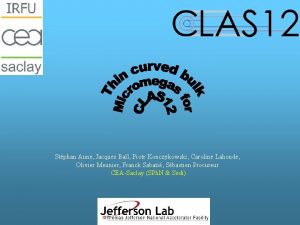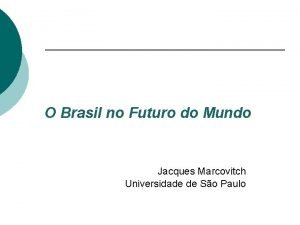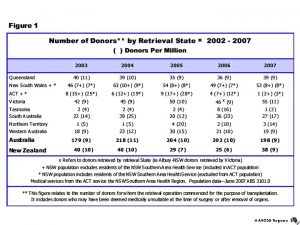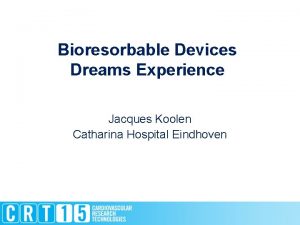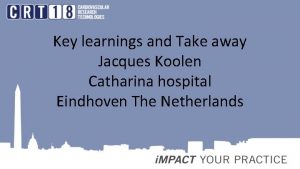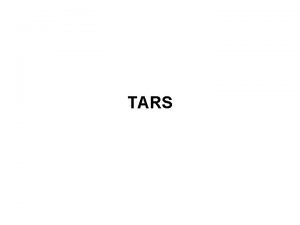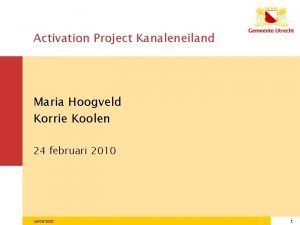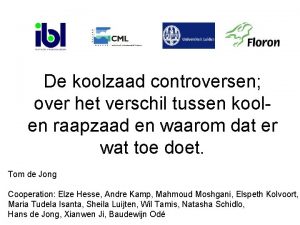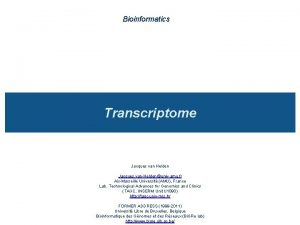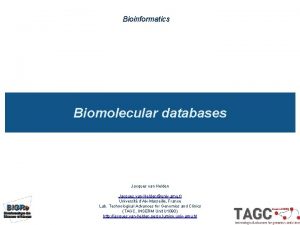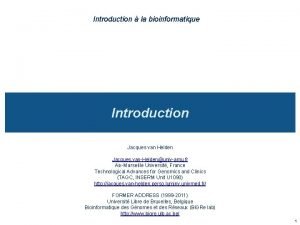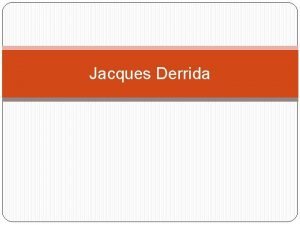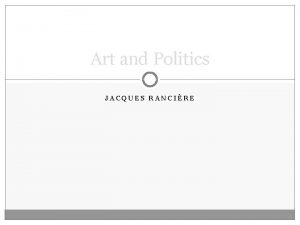European Registry Update Jacques Koolen MD Ph D










![Procedural characteristics § § § § § Occlusion duration 12 [5 -14] months* CTO Procedural characteristics § § § § § Occlusion duration 12 [5 -14] months* CTO](https://slidetodoc.com/presentation_image_h/fa57d9e2ee78362b9bf51013d2ab540f/image-11.jpg)

































- Slides: 44

European Registry Update Jacques Koolen MD Ph. D Aristotle University of Thessaloniki A’ Cardiology Department AHEPA University Hospital

Disclosure Statement of Financial Interest Within the past 12 months, I or my spouse/partner have had a financial interest/arrangement or affiliation with the organization(s) listed below. Affiliation/Financial Relationship Biotronik consultant Company

Euro. Cto Club Founding Meeting Paris 14. 12. 2006 Carlo Di Mario Nicolaus Reifart Gerald Werner George Sianos Joachim Büttner Alfredo Galassi Dariusz Dudek Jaques Koolen Hans Bonnier

Published May 2007 Published May 2008

Galassi, A. R. et al. J Am Coll Cardiol. 2015; 65(22): 2388– 400.

Euro CTO Club Membership 120 101 100 40 13 21 29 33 20 10 60 20 09 80 38 43 55 61 52 20 be r 2 01 5 20 14 Se pt em 20 13 20 12 20 11 20 08 20 07 20 06 0

ERCTO REGISTRY p for trend <0. 001

Numbers of Procedures and Rate of Procedural Success (mean 75. 3%) (mean 16. 5%) Overall Antegrade Retrograde

Procedural Success According to J-CTO Score and Operator Experience >50 cases, 35 centers, 530 patients enrolled <100 cases, 5 centers, 303 patients enrolled >100 cases 4 centers, 562 patients enrolled

Patient characteristics (17626 procedures) 85. 1% male Age 63. 9± 10. 9% BMI 28. 0± 14. 0 kg/m 2 Comorbidities: • Diabetes 28. 6% • COPD 5. 1% • Peripheral artery disease 9. 2% § Prior MI 42. 3% § Prior CABG 13. 7% § Prior PCI 49. 6%; at CTO territory 14. 8% § §
![Procedural characteristics Occlusion duration 12 5 14 months CTO Procedural characteristics § § § § § Occlusion duration 12 [5 -14] months* CTO](https://slidetodoc.com/presentation_image_h/fa57d9e2ee78362b9bf51013d2ab540f/image-11.jpg)
Procedural characteristics § § § § § Occlusion duration 12 [5 -14] months* CTO length 25 [18 -38] mm* Procedure duration 90 [60 -130] min* Fluro time 33 [19 -55] min* Contrast volume 250 [180 -380] ml* In-stent CTO 7. 4% Involving bifurcation 12. 1% Previous attempts 24. 3% (20. 5% one, 3. 3% two, 0. 5% three or more) Transradial access 23. 2% § * summarized as median [25 th-75 th percentile]

Patient characteristics 17, 626 percutaneous revascularization procedures involving CTOs (mean age of patients at the time of the procedure 63. 9± 10. 9 years; 85% male) Parameter Years 2008 -2009 (N=3, 027) Years 2010 -2011 (N=4, 812) Years 2012 -2013 (N=5, 473) Years 2014 -2015(1/2) (N=4, 314) Age (years) 63. 2± 11. 7 64. 0± 10. 7 63. 9± 10. 8 64. 3± 10. 7 <0. 001 Male gender 84. 3% 85. 8% 85. 6% 84. 5% 0. 924 BMI (kg/m 2) 26. 3 27. 6 28. 7 <0. 001 Diabetes 26. 5% 28. 3% 28. 9% 29. 9% 0. 002 Smoking 38. 1% 31. 6% 24. 6% 26. 9% <0. 001 Dyslipidemia 72. 4% 72. 9% 77. 6% 73. 8% 0. 003 Hypertension 68. 4% 71. 9% 74. 7% 75. 9% <0. 001 Peripheral arterial disease 9. 7% 8. 9% 9. 0% 9. 6% 0. 880 Renal insufficiency 0. 0% 1. 1% 1. 5% 1. 7% <0. 001 Prior stroke history 2. 6% 3. 1% 2. 3% 2. 5% 0. 191 Prior MI history 40. 2% 41. 0% 35. 2% 35. 1% <0. 001 p value (for trend)

Patient characteristics (cont’d) Years 2008 -2009 (N=3, 027) Years 2010 -2011 (N=4, 812) Years 2012 -2013 (N=5, 473) Years 2014 -2015(1/2) (N=4, 314) p value (for trend) 48. 9% 51. 8% 46. 9% 51. 2% 0. 881 Prior PCI to the CTO territory 19. 0% 21. 3% 11. 3% 9. 6% <0. 001 In-stent CTO 4. 8% 7. 9% 8. 1% 7. 9% <0. 001 Prior CABG history 14. 9% 12. 6% 14. 2% 13. 4% 0. 540 Prior CABG to the CTO territory 9. 1% 8. 9% 9. 6% 8. 9% 0. 837 LMA 0. 5% 0. 6% 0. 3% 0. 4% LAD 25. 7% 24. 9% 26. 5% 23. 8% LCx 14. 9% 14. 5% 15. 6% RCA 47. 2% 49. 8% 52. 8% 56. 7% Ven. G 3. 5% 2. 8% 0. 9% 0. 6% Art. G 0. 0% 0. 1% 0. 2% Other 8. 1% 7. 0% 3. 2% 2. 3% 2. 87± 0. 40 2. 92± 0. 42 2. 92± 0. 44 2. 94± 0. 43 <0. 001 Parameter Prior PCI CTO artery Vessel diameter (mm)

Temporal trends in utilization of techniques and materials Years 2008 -2009 (N=3, 027) Years 2010 -2011 (N=4, 812) Years 2012 -2013 (N=5, 473) Years 2014 -2015(1/2) (N=4, 314) p value (for trend) Contralateral contrast injection 38. 5% 44. 9% 55. 9% 66. 1% <0. 001 Number of guidewires used 3. 1± 2. 4 3. 3± 2. 7 3. 4± 2. 7 3. 9± 3. 6 <0. 001 Number of balloons used 2. 5± 2. 1 2. 5± 1. 9 2. 6± 2. 0 2. 7± 2. 2 0. 002 Transradial access 16. 2% 19. 4% 22. 2% 33. 5% <0. 001 Intravascular ultrasound 2. 1% 3. 2% 10. 8% 12. 8% <0. 001 Retrograde approach 10. 2% 14. 9% 26. 3% 30. 8% <0. 001 Externalization of retrograde wire 0. 3% 2. 9% 12. 2% 16. 5% <0. 001 Corsair microcatheter 2. 6% 16. 4% 34. 2% 39. 2% <0. 001 Tornus catheter 7. 0% 4. 7% 3. 0% 2. 1% <0. 001 Crossboss crossing catheter 0. 4% 1. 5% 3. 2% 3. 4% <0. 001 Stingray re-entry system 0. 4% 0. 7% 1. 8% <0. 001 Rotational atherotomy 1. 0% 0. 8% 1. 2% 2. 1% <0. 001

Wires to start according to stiffness Ø Ø Soft: 1 g or less Intermediate: >1 g and ≤ 3 g Moderately stiff: >3 g and <9 g Stiff: ≥ 9 g

Wires to cross according to stiffness

Small, but significant, increase (p<0. 001) in procedure duration and fluoroscopy time, and a decrease in contrast volume

J-CTO score

Peri-procedural mortality

Perforations

Any peri-procedural complication* * death, myocardial infarction, stent thrombosis, stroke, perforation, vascular complications, need for emergency surgical intervention or PCI, hemoglobin reduction by >3 g/dl

Changes in Angina and Dyspnea Status After Retrograde CTO PCI Galassi, A. R. et al. J Am Coll Cardiol. 2015; 65(22): 2388– 400.

Conclusions v The number of CTO procedures are ~2. 500 per/year. This number is expected to increase with the expansion of the membership v The complexity of the CTOs attempted over time significantly increased v Success rates are increasing reaching 88% v Procedural complication rates are remaining low (in the range of 4. 5%) with a tendency of increased perforations v In hospital MACE rates are very low (0, 5%).

Conclusions v The number of the retrograde procedures is increasing over time (reaching 30. 8 %) as well as the use of IVUS (12. 8%) and the radial approach (33, 5%) v Medium stiffness GW are increasingly used contributing to the success in more than 50% of the cases. This reflects the adoption in routine clinical practice of the GAIA family v JCTO score is a poor predictor of outcomes especially for the retrogarde procedures

In-hospital MACCE

JCTO score p=0. 011

Overall, J-CTO was higher in failed cases… p<0. 01

while in antegrade ones…

Mean values with 95% confidence intervals of estimated duration and length of CTOs, over the time period 2008 -2015. Duration Length v Occlusion duration increased from 23. 2± 40. 6 months in 2008 -9 to 34. 7± 53. 1 in 201415 (p for trend<0. 001), v CTO length increased from 29. 1± 17. 7 mm to 31. 2± 20. 8 (p for trend<0. 001)

Procedural Complications and In-Hospital Outcomes in Retrograde Lesions

Angina severity


Procedural success

EURO CTO CLUB Krakow 2016 SAVE THE DATE … ›› 2016 8 th Experts "Live" CTO Workshop Sept 30 th – Oct 01 st, 2016 Krakow, Poland ECC-President Alfredo R. Galassi, Italy Course Directors Jaroslaw Wójcik, Poland Leszek Bryniarski, Poland Co-Director George Sianos, Greece Nicolas Boudou, France

Specifically in retrograde cases: In the ROC analysis the J-CTO score is a poor predictor of failure (non-significant) in retrograde cases c-statistic 0. 522 (95% CI 0. 499 -0. 544)

Web based ERCTO Registry

2015 and on 10 % reabstraction of CTO records (n = 250/ year), masked and reviewed by a second abstractor


Statistical analysis v Continuous variables were summarized as mean±standard deviation and compared with one-way analysis of variance. Categorical ones were summarized as percentages and compared with the chi square test. v Temporal trends were tested for significance with polynomial contrast analysis (for continuous variables) or the Cochran-Armitage test (for categorical ones). v Although the reported results are based on analysis of original data, analyses were repeated after accounting for missing values, using multiple imputation methods, to confirm that the original results were not sensitive to missing valuerelated bias. v IBM SPSS Statistics v. 22 software package (IBM Corporation, Armonk, NY, USA) and R language were used for all analyses. v Two-sided p values of less than 0. 05 were considered as indicative of statistical significance.

However, the predictive value of the J-CTO score for procedural failure was mediocre c-statistic 0. 568 (95% CI 0. 556 -0. 579)

Euro CTO Club Membership

European Registry of CTO (ERCTO) v a prospective real-world registry that includes patients with one or more CTO lesions in major coronary arteries or saphenous vein grafts v 44 centers across Europe v all patients undergoing CTO PCI at these centers between January 2008 and June 2015 were registered prospectively using a web-based electronic data collection interface (17, 626 percutaneous revascularization procedures) v no exclusion criteria v the treatment indication was symptomatic myocardial ischemia and/or evidence of reversible myocardial ischemia by perfusion imaging or stress testing, as proposed at the Euro. CTO Club’s position paper v procedural details (demographic data, techniques applied, equipment used, fluoroscopy, complication rate) were prospectively recorded

Flowchart of the Study Population Patients included in the multicenter European Registry of CTOs (ERCTO) Registry from 2008 to 2012.

 Jacques koolen
Jacques koolen Which is an alternative of log based recovery
Which is an alternative of log based recovery Jacques de molay
Jacques de molay Jacques rouveyrollis
Jacques rouveyrollis Collège jacques brel louvroil
Collège jacques brel louvroil Ent jacques brel louvroil
Ent jacques brel louvroil Jacques irani
Jacques irani Barron de montesquieu
Barron de montesquieu Lacann
Lacann Sanamento
Sanamento Jacques cartier
Jacques cartier Jean jacques rousseau escuela nueva
Jean jacques rousseau escuela nueva Jacques madier
Jacques madier Jacques van helden
Jacques van helden Cartier chitila
Cartier chitila Jacques 2 26
Jacques 2 26 Jacques cartier for kids
Jacques cartier for kids 3 forces of psychology
3 forces of psychology Jean jacques nyirubutama
Jean jacques nyirubutama Facts about cartier
Facts about cartier Trèfle chanceux jacques limoges
Trèfle chanceux jacques limoges Jacques charles
Jacques charles Jacques farine
Jacques farine Jacques ferland
Jacques ferland Jacques middlecoff
Jacques middlecoff That prvert
That prvert Jacques panchard
Jacques panchard Ti-jacques la guerre des tuques
Ti-jacques la guerre des tuques Dr adam jacques
Dr adam jacques Les enfants qui s'aiment jacques prevert
Les enfants qui s'aiment jacques prevert The humiliation of the word
The humiliation of the word Jean jacques rousseau biografia
Jean jacques rousseau biografia Jean jacques salim
Jean jacques salim Jacques chaoulli
Jacques chaoulli Nyirubutama
Nyirubutama Xia shang zhou qin han
Xia shang zhou qin han Jacques de molay, tu es vengé
Jacques de molay, tu es vengé D aniello unimc
D aniello unimc Jacques lucien jean delors
Jacques lucien jean delors Michel jazy
Michel jazy Jacques ball
Jacques ball Jacques marcovitch
Jacques marcovitch Klassitsism
Klassitsism Jacques marcovitch
Jacques marcovitch Ime jacques rochas
Ime jacques rochas




